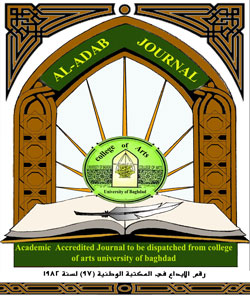Mystical features of Christianity in Persian poetry
DOI:
https://doi.org/10.31973/aj.v0i134.1022Keywords:
A look at Christian mysticism, types of Christian mysticism, several of Iranian poets, Christian mysticism termsAbstract
Religious poems are one of the well-known literary genres who poets began to benefit from its symbolic elements & contents in order to show and clarify their nice and beautiful poetic meanings. Christianity and the life of Jesus are one of the clear example that have been placed before the ascetics and Christian clergy in general and Iranian in particular.
Jesus Christ is a figure who has occupied a prominent position since ancient times, his name and remembrance are present in the mind of every human being. The Christ in Iranian culture is a symbol of freedom, purity and honesty for this reason, these people have painted in their mind a pleasant and likeable image of him.
The Iranian vision of the Christ's prophets arised in the first place by mentioning the signals and several and repeated hints of the Holy Quran to the holiness and purity of the Christian family.
Most writers and poets of Persian literature have used the name of Christ and Christian religious terms widely through Islamic teachings (Holy Quran) to showed that in their poems as a novel and not as a rule so that they did not go in this way without evidence.
In this research, we showed how Iranian poets are influenced by Christianity and its religion terms as well as showed the references some of the meanings and contents common in this regard in their poems.
Downloads
References
Arian, Kammer(1378), The Face of Christ in Persian literarure, Tehran: Sakhn.
Asadpour, Raza(1384), About Christian mysticism, Mamshahry Journal-especiallya kheradnameh, Number 82.
Astace,O.T.(1358),Mysticism&Philosophy, Translation: Bahaalddin Khurramshahi, First Edition, Tehran, Publication&Cultuval Center of Iran.
Attar, Neshabori,faredaleen Mohammad(1388),Divan, introduction&audit Mohammad Raza Shafiee Codecani, Tehran: Sakhn.
Dehkhoda, Ali Akbar(1377), laghatnama dictionary, Edited: Mohammad moin& Jafar shahedy, Tehran, University of Tehran publishing.
Dr. Moin, Mohammad(1381), Persian dictionary(A-S), part one, Tehran: Edna- new way book.
Fanteec, Steven(1383), Christian Mystics, Translation: Fardaldin Radmehr, First Edition, Tehran, Publishing: Gheghnoas.
Farrokhi Sistani, Ali bin Jologh(1335), Divan, edited: Mohammed Dapeer Saighee, Tehran.
Ghobadani, Naser Khosro(1348), Divan, edited : Mehdi Mohaghegh & Mojtaba Minooi, Tehran.
Hafiz, Shams alddin Mohammad(1379), Divan, Edited: Khalil Khatib Rahber, Tehran: Safi Alishah.
Khaghani, badeel ben Ali(1378), Divan, Proofreader Zeyaa aldeen Sajade, part 6, Tehran: Zoar.
Michel, Thomas(1377), Christian speech, Translation: Hossein Tofiqi, Qom: Studyes and researches of religions.
Molavi, Jalaladiin Mohammed bin Mohammed(1370), Masnavi, Part: 1,2,3, proofreader: Mohammed Astaalami, Tehran.
Motahari, Morteza(No date), book Collection , Part1, Qom: Sadra.
Nezami Ganjavi, Elias bin Youssef(1334), El-Asrar warehouse, proofreader: Wahid Dastgerdi, third edition, Tehran.
Rasttco, Seyed Mohammad(1383), Mysticism in the Persian yarn, Tehran: Apractical & Cultural publishing company.
Roodaki, Abu Abdullah Jafar ibn Mohammad(1387), Divan, proofreader Broyz Kareb, Tehran: Zouar.
Saadi, Musleh ibn Abed Allahab(1385), Kuleat, proofreader: Mohammad Ali Froggy, First Edition, Tehran: Harmez.
Sadaqi Tehrani, Mohammad(1390), The beginning of the two covenants, Tehran: publishing shukranh.
Sanaei, Abu Almajed Majdod ibn Adam (1329), Real garden & the law of the way, Edited & proofreadr: Mudres Radave, Tehran.
Sanaei, Abu Almajed Majdod ibn Adam(1347), Divan, Edited: Mohammad Taqe Mudres Radave, Tehran.
Shafeay KIadkane, MKohammad Raza(1390), Ba Jaragh &Wayne(at the basis of the development of contemporary poetry Iran), Tehran: Sakhn.
Shahedy, Dr.Seyed Jafar(1357), explaining the language& problems of Anvari Aburdis divan, poblishing the national society of Antiquities.
Downloads
Published
Issue
Section
License
Copyright and Licensing:
For all articles published in Al-Adab journal, copyright is retained by the authors. Articles are licensed under an open access Creative Commons CC BY 4.0 license, meaning that anyone may download and read the paper for free. In addition, the article may be reused and quoted provided that the original published version is cited. These conditions allow for maximum use and exposure of the work.
Reproducing Published Material from other Publishers: It is absolutely essential that authors obtain permission to reproduce any published material (figures, schemes, tables or any extract of a text) which does not fall into the public domain, or for which they do not hold the copyright. Permission should be requested by the authors from the copyrightholder (usually the Publisher, please refer to the imprint of the individual publications to identify the copyrightholder).
Permission is required for: Your own works published by other Publishers and for which you did not retain copyright.
Substantial extracts from anyones' works or a series of works.
Use of Tables, Graphs, Charts, Schemes and Artworks if they are unaltered or slightly modified.
Photographs for which you do not hold copyright.
Permission is not required for: Reconstruction of your own table with data already published elsewhere. Please notice that in this case you must cite the source of the data in the form of either "Data from..." or "Adapted from...".
Reasonably short quotes are considered fair use and therefore do not require permission.
Graphs, Charts, Schemes and Artworks that are completely redrawn by the authors and significantly changed beyond recognition do not require permission.
Obtaining Permission
In order to avoid unnecessary delays in the publication process, you should start obtaining permissions as early as possible. If in any doubt about the copyright, apply for permission. Al-Adab Journal cannot publish material from other publications without permission.
The copyright holder may give you instructions on the form of acknowledgement to be followed; otherwise follow the style: "Reproduced with permission from [author], [book/journal title]; published by [publisher], [year].' at the end of the caption of the Table, Figure or Scheme.











